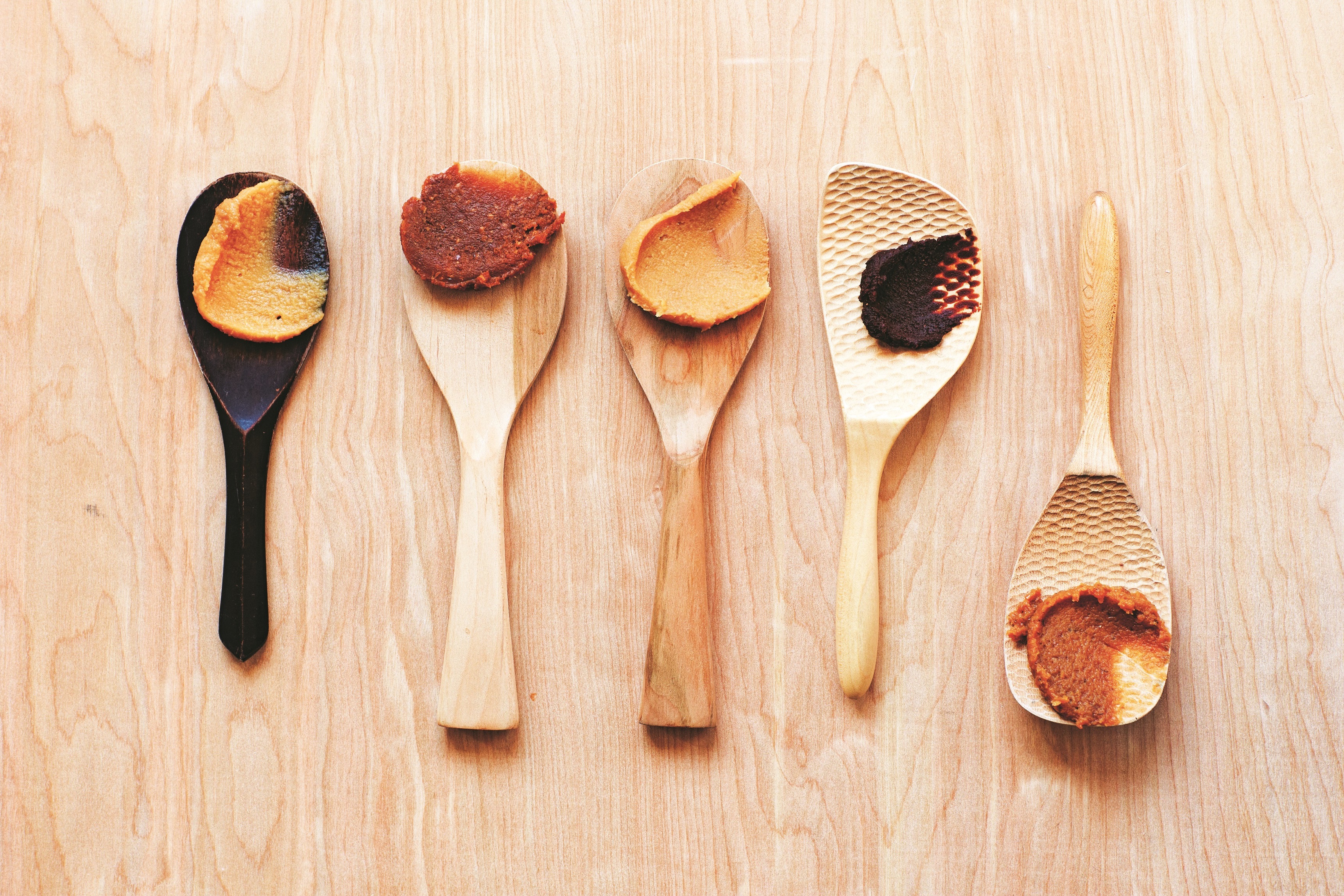Miso is a fermented soybean paste made with a grain such as rice or barley, sea salt, water, and a culture known as koji mould. As with fermented foods like cheese, kimchi, or sauerkraut, miso’s flavour and intensity builds the longer it ferments.
Intrigued by her miso-centric cookbook, Miso Tasty, I discussed the intense and aromatic power of miso with author Bonnie Chung. In Johannesburg, we’re not exposed to authentic miso, let alone the countless types available in Japan.
In the book, Chung explains how Japanese class structure defined miso consumption: “Wealthy landowners, royalty, or samurai would only eat rice miso made using expensive polished rice. Peasants and farmhands used any broken rice, or other grains such as millet or barley. This explains why darker miso made from these grains has a reputation, even today, as ‘poor man’s miso’.’’
There are endless varieties of miso. For simplicity, Chung defines five basic types based on ingredients used and the length of fermentation:
Rice miso is the most common type in Japan, and is fermented for various lengths of time to craft different flavour profiles. A white rice miso fermented for three months has a sweet, custard-like flavour, a six-month miso (shiro miso) produces gentle sweet and salty tones, while a 12-month (red miso) has a sharper tang with a more pungent aftertaste.
Brown rice miso (genmai miso) has a “deep, complex flavour, closer to barley miso and with more nutrients than traditional white rice miso”.
Barley miso (mugi miso) is usually aged for longer than rice miso. It’s higher in protein and lower in carbohydrates, making it less sweet, with a more rounded, malty flavour.
Last, you get a pure soybean miso (mame miso) which is made with no grains at all, just soybeans, salt, and koji. Chung says the most famous type is hatcho miso, made in Nagoya, and is the only miso certified to supply the Emperor of Japan.
Hatcho miso is very dark, with a consistency similar to fudge. It is slightly dry and crumbly, with a strong, tangy flavour. Due to its high protein content, the samurai carried miso fermented for three years, called a “three-winter” miso, for sustenance on long journeys.
 Photo from Miso Tasty (Pavilion Books). Photographer: Yuki Suguira
Photo from Miso Tasty (Pavilion Books). Photographer: Yuki Suguira
As a fermented food containing live cultures, miso is good for gut health and aids digestion. Chung told me the aromatic qualities and nutritional benefits are damaged when miso is boiled or overcooked. Miso should be stirred in at the final stage of cooking to preserve its nutrients and delicate flavour.
For those who are unfamiliar with miso, Chung suggests an easy noodle soup to get your palate used to the flavours of miso. Simply stir miso paste into warm chicken stock, add ramen noodles, and top with vegetables and shredded meat. To avoid lumps, use a strainer to slowly melt the miso into the stock.
Chung explained that cooking with miso is all about balance. Long ferment miso is strong and tangy so it needs to be cut with other flavours. Introducing counter-balancing flavours like sesame oil, citrus, or sweeteners like honey or mirin, can elevate the heaviness of a strong miso.
In Johannesburg, it’s rather difficult to find authentic miso. Certain Asian supermarkets stock a Kong Yen brand, and Woolworths stocks a Hikari brand, but it’s unclear which type of miso these brands are, or how long they were fermented for.
One local supplier is making authentic miso more widely available to the Joburg market. Tabu Food, based in Pretoria, is importing authentic Japanese miso in four distinct types: shiro, mugi, genmai, and hatcho miso. Their miso products are available at Jackson’s Real Food Market, Green Guru, Fresh Earth Food Store, and Organic Living (Cape Town).
 Photo from Miso Tasty (Pavilion Books). Photographer: Yuki Suguira
Photo from Miso Tasty (Pavilion Books). Photographer: Yuki Suguira
Co-founders Anita van Wyk and chef Mika Zorgman started the business seven years ago. After returning from Japan, they searched (without success) for authentic Japanese ingredients in South Africa.
What started as importing ingredients for their own home cooking slowly turned into a business. Tabu Food imports organic, non-GMO miso from a Japanese supplier named Muso. Van Wyk and Zorgman visited the Muso miso farm, witnessing authentic miso production using large oak barrels, with heavy rocks piled on top to prevent air from entering during fermentation.
Van Wyk and Zorgman’s particular favourite is genmai miso which is fermented for 18 months. When cooking, they often use it instead of stock or salt to add umami and depth to their meals. Van Wyk urges customers to store miso in the pantry rather than the fridge because the cold kills the healthy live cultures contained in their organic miso.
In Miso Tasty, Chung uses miso to add a slightly savoury profile to desserts, similar to adding sea salt to caramel. Her book features decadent delights like stem ginger and barley miso cheesecake, red miso panna cotta, and miso caramel sauce.
If, like me, you’re afraid of boiling sugar, try this simple miso date caramel – perfect as a spread on banana bread or swirled into oatmeal for an indulgent breakfast treat.
Miso date ‘caramel’
1 cup pitted dates, roughly chopped
1 tbs maple syrup
2 tsp smooth nut butter
1/2 tsp vanilla extract
2 tbs shiro miso
-
Place your dates and one cup of water in a saucepan. On medium heat, gently stir the dates until they form a paste and all the water has been absorbed.
-
Turn down the heat, and mix in the maple syrup, nut butter, and vanilla. You can add a little more water if the paste is too thick.
-
Take the pan off the heat, and stir in the miso till combined. DM




 Photo from Miso Tasty (Pavilion Books). Photographer: Yuki Suguira
Photo from Miso Tasty (Pavilion Books). Photographer: Yuki Suguira 